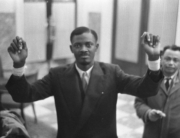Though the Holocaust’s most atrocious deeds happened out of public view, what’s truly disturbing is how much of Hitler’s goose steppers had it documented. The Nazis likely wanted future generations to observe their crimes as the Third Reich’s “moral victory,” only to frantically cover everything up once the tide of World War II turned against them. From Where They Stood looks at these horrors from a reverse angle: the concentration camp photos taken from within, by prisoners who had no idea whether this evidence would fall into Allied hands.
These are not your standard big-name WWII heroes. They were political prisoners and resistance members who defied the Nazis, but few people will recognize the names of Czechoslovakian Rudolf Cisar, Belgian Jean Brichaux, or the Frenchwoman Anise Postel-Vinay. We never even see their faces. All that’s left is their clandestine photo reels—some clear images, others fuzzy negatives. It’s in the hands of French director Christophe Cognet to address the significance behind these images. Where did each person take their photos, and what exactly were the photographers trying to capture?
Cognet is no stranger to Holocaust stories, having worked on previous documentaries like 2013’s Because I was a Painter. But From Where They Stood has no real linear structure. Instead, Cognet offers a series of archeological vignettes, analyzing the recovered film rolls for details to explain each photo’s origins, sometimes with Holocaust historians and their translators. Cognet doesn’t include musical cues to underlie his analyses’ impact, often just the ambient sounds in the camps’ woodland is heard.
There’s almost a CSI–inspired detective element to this documentary. With each set of photos, Cognet and his allies approach the images like they were dissecting a crime scene. They search for that familiar looking tree branch or gas chamber ruin in the present day that syncs up with the original photographer’s gaze, re-creating where each prisoner stood just before the shutter clicked. At times, Cognet makes this contrast between past and present deliberate, placing a blown-up image on a stand and letting it blend into the present-day environment. The landscapes now surrounding the camps remains are serene, colorful even. But align that with a shot of Jews being herded into a nearby building, and the land’s former purpose as a death machine becomes unmistakable, not to mention chilling.
Of course, this theme of nature masking death is quite explicit. Near the start of the film, Cognet notices some white pieces mixed with the soil outside a concentration camp’s grounds. At a glance, one might dismiss these objects as stones or shells. As it turns out, they’re bone fragments. “The last human remains that couldn’t be cremated away” his guide informs him, speaking to how callously the Nazis desensitized themselves to genocide. The same sentiment even applied to their prisoners. A later shot reveals a Sonderkommando team pulling bodies out of the gas chambers, with one man tiptoeing around the corpses like he’s done all this before. The implications are stark: The inmates have gone through the motions so many times that they’ve learned to live with death.
At least that’s the subtext. Maybe Cognet wanted to gradually build up the scope of his subject matter—from medical facilities and barracks to the infamous gas chambers—to point out how much death camp activity was physically captured. But it doesn’t signify any cohesiveness. His film becomes more of an extended lecture than a deep dive into the photos’ wider connection to Holocaust narratives.
As one From Where They Stood title credit notes, “regaining control of one’s image” was itself a way to oppose the Nazis. The featured photos are simple, unflinching, microcosms of the terrors Jews and resistance prisoners were forced to accept as mundanity. There just seems to be little beyond those microcosms. Though it reveals quite a bit, From Where They Stood’s biggest hindrance is its own abstractness, so focused on the pictures that it ironically struggles to translate their impact through the power of cinema.







Leave A Comment